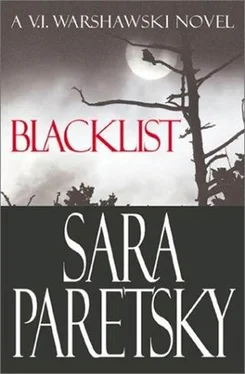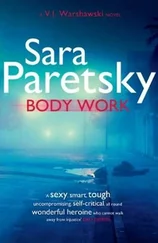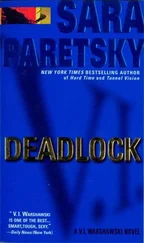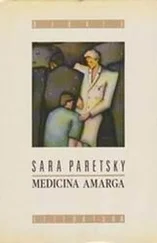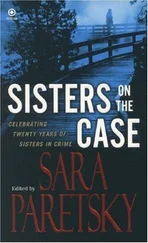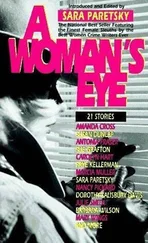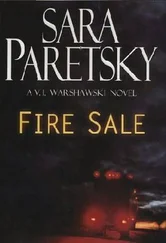When I asked if there were other Ballantine papers anywhere-a diary, or financial records, Reed shook his head again. “If there are, they’re not in a public archive. Her estate didn’t amount to much, and even though she was highly respected in the black community, no one had the kind of
money to do preservation or restoration in her home-it had to be sold to pay her debts. If there was some kind of trove of documents, I’m thinking they’re in the CID landfill by now.”
Reed paused to answer a question from a woman who’d been waiting for several minutes, then turned back to me. “Mr. Whitby did go through her old house. After she died, the bank or whoever bought it cut it into a bunch of little apartments, but Mr. Whitby hoped something might have been left in a basement or crawl space.”
“Did he find anything?”
Reed slowly shook his head. “That may have been why he called me, maybe a week or ten days ago. I wasn’t in and he left a message for me. I never did reach him when I tried calling back, but that could have been it-he knew I shared his interest in Kylie. If he’d found some papers, well, he would have wanted to show them to me.”
Another patron was trying to get the archivist’s attention. I turned to leave, feeling frustrated at how little information I was able to collect.
As I walked away from his desk, Reed called out to me, “Let me know what you find out about Mr. Whitby. If you get to the truth, it may not make the evening news, you know”
A sad commentary. Kylie Ballantine’s life should have been seen on stage, under spotlights, but she’d died in the wings, and now Gideon Reed was afraid her lone champion was going to vanish into the same shadows.
I imagined melodramatic statements I might make, picturing myself as Annie Oakley riding to the rescue of both Ballantine and Marcus Whitby. Maybe I was just Lassie the dog, though, barking around frantically for help.
“Timmy’s in the well,” I said aloud as I unlocked my car. A woman with a couple of toddlers passed me just then, but she barely spared me a glance: people saying odd things to themselves are commonplace at the public library, after all.
Crocodile in the Moat
I’m going out to New Solway,” I told Amy Blount when I reached her on her cell phone. “I didn’t find anything definite in the Ballantine papers, but there’s a possibility that Marc tried seeing Calvin Bayard, who published one of Ballantine’s books. I want to talk to Mr. Bayard, if I can get in-his wife has a shark-filled moat dug around him. Did you find out anything?”
“Like you, nothing definite. The woman who lives on Marc’s south side thinks she saw lights at three yesterday morning-she’s got a newborn who woke her up around then, and she was rocking by the window, but she wasn’t really paying attention. She couldn’t be a hundred percent sure it was Sunday-she’s up most nights and she’s pretty sleep deprived. And anyway, she didn’t look at the front walk, so she wouldn’t know if it was Marc or an intruder. The old man across the street, he save Marc bring a woman home with him once or twice, but no one had spent the night here for several months, as far as the local gossip columns know.”
I was on Ninety-fifth Street, heading west to the tollway, doing the worst kind of driving: the steering wheel wedged between my knees, one hand on the cell phone, one on a raspberry smoothie I’d picked up in lieu of lunch. When I had to brake for a semi that suddenly changed lanes, I dropped the smoothie.
I swore and pulled over to the curb, where I daubed pink liquid from my green-striped trousers. I’d lost the connection by the time I finished with my clothes. When I redialed I asked how many people Amy had left to talk to. She hadn’t reached the neighbor on his north, or the kids-school wouldn’t get out for another hour.
“If you have the time, stay down there until you talk to some of the kids. What about the autopsy? Have the Whitbys come to a definite decision on that? They have? Then I’ll find a funeral director who will get Mare’s body from DuPage and deliver it to Bryant Vishnikov.” That was the kind of detail Mary Louise Neely knew from her years of police work; I’d give her a quick call at her fancy new office.
“Finally,” I said to Amy, “do you think Harriet is up to a trip to T-Square? I’m wondering if Simon Hendricks-Mare’s editor-knows more than he would tell me about Mare’s current project. Maybe he’d be more forthcoming with you and Harriet.”
“What should I say?” Amy asked.
“Mare’s assistant-Aretha Cummings-thinks Hendricks was jealous of Mare’s abilities. Start with Aretha, see if you can get something specific to use as a lever. Usually, two emotions start people talking-resentment or sympathy. So try to get Hendricks feeling sorry for Harriet and the Whitbys. Talk about their need for closure. But if that doesn’t work, see if anything Aretha tells you will goad him into revealing something. Augustus Llewellyn, he owns T-square and all those other magazines, has a policy against talking to anyone at Bayard. I want to know if that’s truly a policy about not going to any competing publisher, or if there’s some specific issue between Llewellyn’s enterprise and Bayard’s. The guy in the cubicle next to Marc, Jason Tompkin, seems willing to talk.”
“I can try,” she said doubtfully, “but I’m not very skillful sorting out office politics.”
I was about to give her a hearty pep talk, but her words triggered a memory from my encounter with Renee Bayard. “I think you’re up to the job-but there is something you might find on the Web or the SEC or even from Aretha Cummings: Calvin Bayard helped Llewellyn get his original financing. There’s some history there, something that made Renee Bayard think Llewellyn wouldn’t respond to a call from her. See if you can
pick up anything on that. If I manage to see Calvin Bayard, I’ll ask him, too. Let’s talk tonight, okay?”
While I finished my smoothie, I called Mary Louise. We had a quick chat about her new job, which she confided was more work and less excitement than she’d hoped for. As I’d thought, she knew a funeral director whose fees were reasonable and who knew the ropes at the county morgues. First I called Deputy Protheroe, and told her the paperwork on Marc Whitby’s body might be getting ready to show up. Then I called Mary Louise’s funeral director, who set up the transfer for the next morning. Finally, I left a message on Vishnikov’s voice mail to tell him to expect Marc Whitby’s body. Only then did I reenter traffic.
With both hands on the wheel I was the model of the good driver, feeling superior to the people with books propped on steering wheels, cell phones in ears, hamburgers in mouths. As if to reward me, I had an easy run all the way from Kedzie to the tollway, and made it to the Warrenville Road exit well ahead of the afternoon rush.
When I reached the turnoff to Coverdale Lane, I pulled over to inspect my detail map. The woods behind Larchmont Hall belonged to a sort of common area in the middle of New Solway. The Bayard and Larchmont estates were about four miles apart if you followed the road, but only a mile if you went through the woods. I supposed that’s what Catherine did Sunday night-skittered through the underbrush home. Even if I hadn’t fallen in on top of Marc Whitby, I probably couldn’t have kept up with her in the dark through woods she knew well.
All the way out to New Solway, I’d tried to think of a persuasive argument to get me into the Bayard house. Nothing came to me. Maybe I’d park at Larchmont and cut through the woods myself. But when I found 17 Coverdale Lane, the gates to the Bayard estate stood open. I turned through the stone gateposts onto the carriageway. After winding about half a mile through old trees, I came to a four-story mansion, its stone facade aged to a golden gray. Like Larchmont, the Bayard grounds also held a series of outbuildings: garage, stable, greenhouses, a barn. The surrounding gardens and meadows fed into the woods.
Читать дальше
